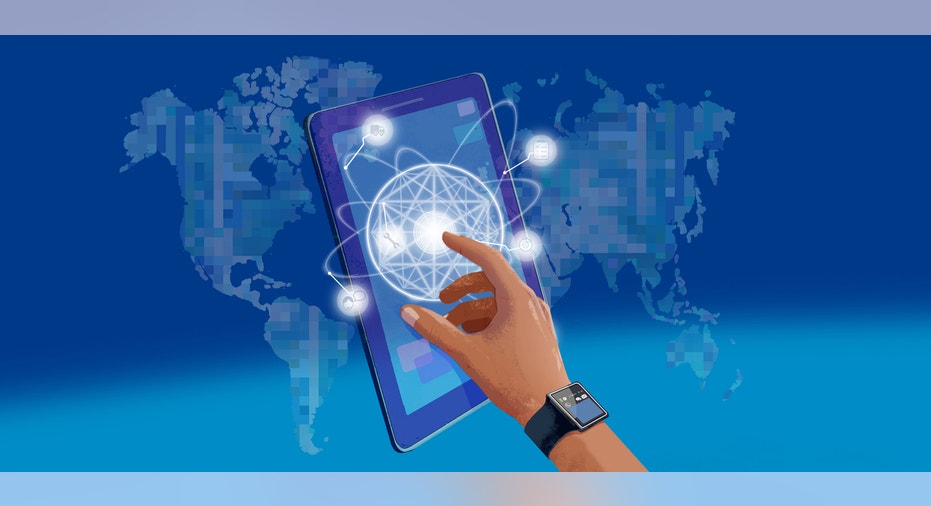The Rise of Digital Supply Networks

Traditional supply chains progress in a very structured manner, with each step dependent on the one before it: develop, plan, source, make, deliver, support. However, supply chains are currently transitioning from a static, linear sequence to a dynamic, interconnected open system known as a Digital Supply Network (DSN).
In “The Rise of the Digital Supply Network,” Deloitte describes how the transformation to a virtual, connected world under DSNs presents an opportunity to drive business value through the supply change, and could lay the foundation for how companies do business in the future.
Technological Evolution
Aided by the drastic decline in computing costs the last few decades, companies have been able to invest less money and still enjoy the benefits, resulting in an increase in digital technology. And an increase in computing power and technological capabilities have allowed organizations to handle larger amounts of data than ever before; increasing from 1 zettabyte in 2010 to potentially 44 zettabytes of data by the year 2020.
A lower transaction cost enables more of them to be made, and maybe even with different partners, opening up new business opportunities. Less equipment is needed as physical capabilities become more sophisticated, providing another cost-saving and efficiency-increasing avenue for businesses to take advantage of.
The improved technology has enabled companies to create value in new ways, like combining information technology (IT) and operations technology (OT), ushering in the next era of Industry 4.0. Industry 4.0 identifies with technologies that blur the lines between the physical and digital worlds.
Deloitte believes this digital revolution—combining real-time access with powerful analytics and the current capabilities of physical technology—has tremendous implications for the supply chain; changing how products will be designed, created, and delivered.
The resulting impact, according to Deloitte, is that “companies can now gather vast data sets from physical assets and facilities in real time, perform advanced analytics to generate new insights, and execute more effective decisions…[that] can then be actualized by...robotics, drones, [or] additive manufacturing.”
Supply Chain Shift
Supply chains, in essence, revolve around the movement of materials or goods, and the exchange of assets—time, money, data, physical goods. A traditional supply chain relies on a much more linear and deliberate sequence of exchanges than in a DSN, where each node is connected independently (see Figure 2).

In this dynamic digital structure, each branch of the DSN becomes more capable and more visible. The transparency and two-way communication between each node—connecting previously disconnected links in the supply chain—result in better collaboration and help eliminate the inefficiencies of the traditional method. Insight into each step of a supply chain makes it less expensive and time consuming to make changes on the fly.
Inventory fluctuations based on customer demand, for example, used to cause a delayed reaction up the chain. With a DSN that employs real-time data, the supply chain can adjust on the fly and catch up or slow down production as needed, either getting more products to a market that demands it, or saving inventory.
The interconnected system will reduce the latency between getting data and taking action. Bolstered by the influx of information “the new interconnections between processes and subprocesses have transformed supply chains into efficient and predictive networks.”
DSN's Strategic Role
As Deloitte points out, “one of the benefits—and challenges—of the DSN is its agility, and the multitude of options companies can pursue to build one. Thus, as companies determine the strategy they wish to pursue, they should identify the type of supply network needed to achieve it.”
Organizations will likely have more than one DSN, with some working together—like manufacturing different products at the same facility. In this case, they can match a DSN to meet the specific needs of a particular area of the business. Or, capitalizing on how sophisticated they can be, a DSN can be customized to address a specific goal—quickest method, lowest cost, highest quality—eliminating the need for the trade-offs an organization would typically have to balance based on their priorities.
In this way, DSNs take on a strategic role in decision-making. This customization allows for a much more flexible supply chain that can strategically and simultaneously achieve the many goals of the business.
DSNs and Business
For those businesses used to a traditional supply chain, moving to a DSN with real-time data access and Industry 4.0 technologies represents a dramatic shift in how information is handled in both the digital and physical worlds. The mitigation of traditional time and space barriers enables businesses to achieve new levels of performance, and the flow of real-time information has removed silos and connected the entire supply chain; changing the way decisions are made. All this adds up to greater flexibility and increased efficiency, providing businesses with more options and more ways to win.
To get started building a DSN, Deloitte advises: thinking big, starting small, and acting fast. Decide what is possible and push the organization to understand what the potential impacts are. Narrow it down and start small where the stakes are low and consequences aren’t drastic. Once you achieve success, build on it, take more chances, and market your success within the organization and to customers.
Once an organization determines their strategy, they should evaluate how they can use supply chains and DSNs to effectively meet those needs.



















